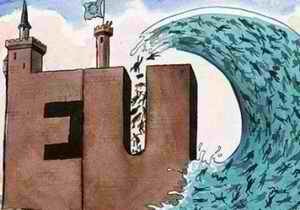
2015 presented new challenges to the security of the united Europe. Europeans had hardly come to themselves from the consequences of the Russian aggression against Ukraine in 2014-2015 (the annexation of the Crimea and the occupation of a part of the Donbas) when they faced a new threat — the “immigration invasion.”
European borders did not stand in front of hundreds of thousands of migrants from the Middle East and North Africa, who were forced to leave their homes and set life, destroyed during civil wars as a result of internal instability, abuse, and in some cases, outright genocide (the destruction of the Yezidis in Syria and Iraq by terrorists of the so-called “Islamic State”). According to the European Commission, in conflict regions around the borders of Europe today is concentrated up to 40 % of the world's refugees and internally displaced persons. Opening (in mid-June 2015) by the Government of Macedonia of the country's borders for the transit of migrants, and changes in the policy of the Syrian government of B. Assad (calling reservists for military service and at the same time simplifying the procedures for obtaining passports for Syrians) have led to the whole “wave” of migration from the Middle East. Russia's direct intervention into the Syrian conflict at the end of September has led to the escalation of hostilities in the region and an even greater increase in flows of refugees to Europe.
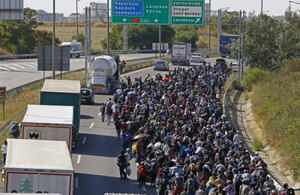 Reacting to the development of these events, the European leaders have made Herculean efforts to keep the situation under control — numerous conferences, extraordinary meetings and summits, revision of budgets and additional funding, strong statements and warnings... It did not help, and led to more than a million illegal migrants' “having settled” in European countries, EU Member States started closing their borders, and the European Union itself is under threat of collapse.
Reacting to the development of these events, the European leaders have made Herculean efforts to keep the situation under control — numerous conferences, extraordinary meetings and summits, revision of budgets and additional funding, strong statements and warnings... It did not help, and led to more than a million illegal migrants' “having settled” in European countries, EU Member States started closing their borders, and the European Union itself is under threat of collapse.
November 9, 2015, the Minister of Foreign Affairs of Luxembourg Jean Asselborn said that this development of events would put an end to the Schengen area of free movement. Warning about the risk of the collapse of the European Union under pressure from the migration crisis, Jean Asselborn said: “If instead of solidarity, the disunity dominates, and the basic rule would be the restriction of movement of people — the EU could fall apart, and it will happen very quickly”. In his view, the EU perhaps has only a few months to solve this problem.
In his turn, the President of the European Commission, Jean-Claude Juncker, November 25, 2015, stressed that the Schengen system is “partially in a coma,” while without the Schengen zone, functioning of the common European currency “Euro” is impossible.
“Borysfen Intel”'s experts offer here their own analysis of the causes and preconditions for this kind of dramatic warnings and pessimistic forecasts for the European Union's future, taking into consideration the reality, the scale of the threats from the “immigration invasion” and its possible consequences for Europe and for Ukraine.
The Migration Threat and Europe's Reaction
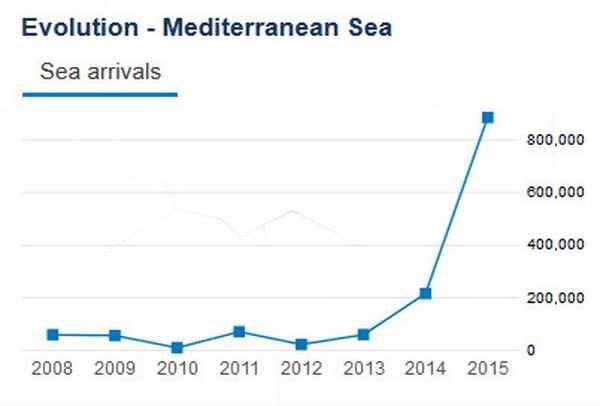 According to the European Agency for the Management of Operational Cooperation at the External Borders of the Member States of the European Union (FRONTEX), since the beginning of 2015, more than 1.2 million migrants have arrived in the EU countries. At the same time, according to the International Organization for Migration (IOM), to Europe in 2015 have come more than 907 thousand migrants, including by sea — up to 880 thousand. In recent months in Greece from Turkey on some days were arriving up to 10 thousand illegal immigrants.
According to the European Agency for the Management of Operational Cooperation at the External Borders of the Member States of the European Union (FRONTEX), since the beginning of 2015, more than 1.2 million migrants have arrived in the EU countries. At the same time, according to the International Organization for Migration (IOM), to Europe in 2015 have come more than 907 thousand migrants, including by sea — up to 880 thousand. In recent months in Greece from Turkey on some days were arriving up to 10 thousand illegal immigrants.
It should be emphasized that the flows of migrants arriving in the countries of the southern coast of Europe (Italy, France and Spain) through the Southern Mediterranean (up to 144 thousand people since the beginning of 2015) are times smaller than the amount that get from Syria via Turkey and the Aegean Sea to Greece (more than 750 thousand people).
The sudden surge in the scale of illegal migration to Europe in 2015, has, in fact, demonstrated the weakness and unpreparedness of both the European institutions responsible for the protection of external borders and sheltering: the agency FRONTEX and the European Asylum Support Office (EASO), and the frank failures of European policy of border controls, such as:
-
 The democratic and humane rules for dealing with illegal immigrants;
The democratic and humane rules for dealing with illegal immigrants; - Dominating of the “humanitarian” approach — as to refugees and asylum seekers, rather than the “police” one — as to illegal immigrants;
- The relative transparency of the internal borders of the European countries;
- The low efficiency and actual failure of sea operations of the EU to protect the southern borders of Europe: the EU's military operation to counteract the illegal migration in the Mediterranean EU Navfor Med/SOPHIA, as well as border control operations under the auspices of the agency FRONTEX — Triton (southern Mediterranean near the Italian coast) and Poseidon (in the Aegean Sea off the coast of Greece).
It took European leaders nearly half a year to decide on more stringent rules for dealing with migrant smuggling and human trafficking. As early as in June 2015, the first phase of the EU's military operation in the Mediterranean EU Navfor Med began, during which was focusing on surveillance and assessment of human smuggling and trafficking networks. The beginning of the next (force) phase of the operation, was agreed on by the EU Council September 14, 2015. And only October 7, within the framework of this operation, which received a new name SOPHIA, the staff of naval forces of the EU was authorized to inspect ships suspected of using for the illegal transportation of migrants.
 It is significant that this EU's initiative was firmly counteracted by Russian diplomats at the United Nations, which managed to significantly limit it. After a long negotiation, the UN Security Council by its Resolution № 2240 sanctioned such an operation only two days later (October 9), after the actual start of it, and limited the time for it (one year) and scope (only in the high seas off the coast of Libya). Such a delay in taking measures against the migrant smugglers or traffickers and their inefficiency had led to the expected result — in October 2015, in Greece across the Aegean there arrived a record number of migrants — 210 thousand people.
It is significant that this EU's initiative was firmly counteracted by Russian diplomats at the United Nations, which managed to significantly limit it. After a long negotiation, the UN Security Council by its Resolution № 2240 sanctioned such an operation only two days later (October 9), after the actual start of it, and limited the time for it (one year) and scope (only in the high seas off the coast of Libya). Such a delay in taking measures against the migrant smugglers or traffickers and their inefficiency had led to the expected result — in October 2015, in Greece across the Aegean there arrived a record number of migrants — 210 thousand people.
This development made Europe take urgent additional measures to overcome the crisis.
November 18, 2015, the European Commission declared the Review of the European Neighbourhood Policy, which establishes a new framework for the EU's relations with 16 neighboring countries — to the east and south of the European Union (including Ukraine). For the first time in this format of the EU's interaction with its neighbors, there appeared security tools, including — the struggle against migration (both regular and irregular) and its causes.
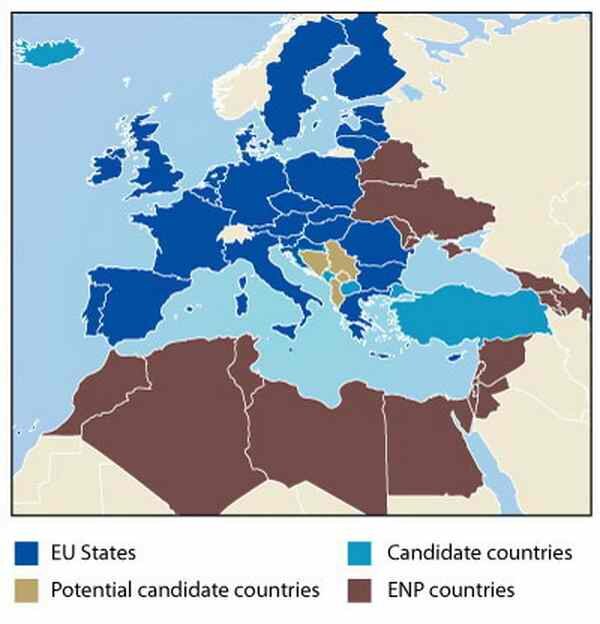 It is believed that in this regard Ukraine may get a chance to be invited (as the EU's partner-country on an individual basis) to participate in the military operations of the EU (EU Battlegroups), as well as to participate in the relevant agencies — such as the European Defence Agency and the European Security and Defence College.
It is believed that in this regard Ukraine may get a chance to be invited (as the EU's partner-country on an individual basis) to participate in the military operations of the EU (EU Battlegroups), as well as to participate in the relevant agencies — such as the European Defence Agency and the European Security and Defence College.
November 20, 2015, at the meeting in Brussels, the Ministers of Justice and Home Affairs of the EU countries agreed to strengthen controls on the external borders of the European Union. Into the approved by the EU Council conclusions there were introduced enhanced inspections and passport control on the external borders for citizens of member countries of the European Union. Such a measure, adopted against the background of recent terrorist attacks in Paris, first of all is intended to counter the increase in the level of the terrorist threat from the EU citizens returning to Europe after a stay in the ranks of the “IS”. However, the Netherlands made a proposal to create a “mini-Schengen” where this passport control would not take place (in the Benelux countries, Austria and Germany). In the context of the migration crisis, the countries have agreed to improve the collection of illegal migrants' fingerprints, to strengthen borders with rapid response teams and border police, to provide additional powers to the border agency FRONTEX.
November 25, the Prime Minister of France Manuel Valls said that the European countries had already reached their limit in the migration crisis and could not accept more refugees. According to him, effective control of the external borders of the EU is crucial for the future of the European Union, and it is necessary to find effective solutions, primarily with Syria's neighbors — Turkey, Lebanon and Jordan.
It should also be noted that in the struggle against migration and terrorism, in December 2015, the European Commission is going to create a European Border and Coast Guard and in January 2016 — a European Counter Terrorist Centre (ECTC). The EU Commissioner for Migration, Home Affairs and Citizenship Dimitris Avramopoulos, went even further, stating the need for a European Intelligence Agency to effectively provide the European agenda with security issues.
What will happen to Europe?
Continued migration pressure. In 2016, despite some forecasts and expectations of decrease in migration flows to Europe, the scale of “immigration invasion” will remain the same (according to the European Commission — up to 3 million refugees in 2015-2016). This is due, first of all, to the escalation of fighting in Syria and northern Iraq, the continuing unstable situation in other countries of the Middle East, Central Asia, North and Central Africa.
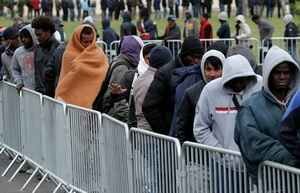 According to the United Nations High Commissioner for Refugees (UNHCR), 62 % of migrants to Europe are male (according to the agency FRONTEX — almost 70 %). This causes the experts' not unfounded fears that after receiving official status in European countries, such refugees will be joined by their families who remain at home (thus increasing the scale of migration in the next year).
According to the United Nations High Commissioner for Refugees (UNHCR), 62 % of migrants to Europe are male (according to the agency FRONTEX — almost 70 %). This causes the experts' not unfounded fears that after receiving official status in European countries, such refugees will be joined by their families who remain at home (thus increasing the scale of migration in the next year).
However, the population of the European Union today is more than 500 million (including 33 million migrants, who make up to 7 % of the total EU population). Even with the arrival by the end of 2015 of a record number of migrants, which could reach 1.5 million, this will be only one-third percent of the total population of the European countries (The European Commission forecasts even less — 0.2 %). Besides, in 2010-2014 each year 1.35 to 1.45 million migrants had been coming to Europe, which was not considered a significant threat to European countries.
Reorientation of migration flows to land sections of Europe's eastern borders. At present, the main route to the European shores of the “seekers of a better life” is the sea one, so the record increase in the flow of migrants in summer and autumn months (up to 220 thousand in October 2015) is natural.
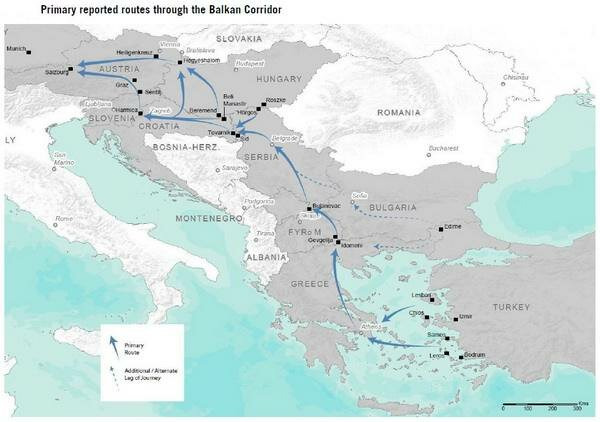 It is believed that in the winter-spring period of 2015-2016, as weather conditions become worse, there will be a relative decline in the number of migrants and their flows will be reoriented to land sections of European borders. But, in contrast to the trends of previous years, according to the vast majority of experts, such forecasts may not come true, as almost 80 % of migrants and refugees this year have used a short and relatively safe route from the Turkish coast to the Greek islands.
It is believed that in the winter-spring period of 2015-2016, as weather conditions become worse, there will be a relative decline in the number of migrants and their flows will be reoriented to land sections of European borders. But, in contrast to the trends of previous years, according to the vast majority of experts, such forecasts may not come true, as almost 80 % of migrants and refugees this year have used a short and relatively safe route from the Turkish coast to the Greek islands.
The new routes of migration flows of refugees may be as follows:
- From Afghanistan and Iraq — through Central Asia and Russia;
- From the Middle East (especially from Syria and Iraq):
- Via Turkey and its land borders with Bulgaria and Greece, or through sea border with the countries of the Black Sea basin;
- Via the South Caucasus and Russia.
Rising costs for maintenance and support for refugees. Individual European countries and the EU as a whole have already spent significant funds to resolve the migration crisis. Because of transit and arrival of a significant number of migrants, the financial burden on local budgets and government spending have increased. It is predicted that in 2015 and 2016 to resolve the problem of refugees, from the budget of the European Union alone there will be allocated 9.2 billion Euros. For example, in November the European Commission decided to allocate 1.8 billion Euros from the “EU Emergency Trust Fund to Africa” to curb the flow of refugees from North Africa and the Middle East, and 3 billion Euros of financial assistance to Turkey, which has more than 2.2 million Syrian refugees. November 25, 2015, France and Germany announced about the creation of a special fund (in the amount of 10 billion Euros) to meet the refugee problem.
At the same time, the latest economic forecast of the Directorate-General for Economic and Financial Affairs (DG ECFIN) of the European Commission, of November 5, 2015, for the first time gives a positive assessment of the economic impact of the arrival of a large number of migrants in the EU — in the medium term an additional positive effect is expected from the growth of labor supply, provided the right policies to facilitate the migrants' access to the labor markets. For example, DG ECFIN forecasts that Sweden, which in 2015 took the largest number of refugees per capita of the population, by the end of 2015 may have up to 0.5 % of additional growth of its GDP.
The growing terrorist threat. An example of this is a terrorist attack in 2015 in France (in January and in November) and in Denmark (in February), attempts to carry out terrorist attacks in Belgium (at the beginning of the year and in November), as well as in the UK (according to the British Prime Minister D. Cameron, the country's security services have prevented seven terrorist attacks).
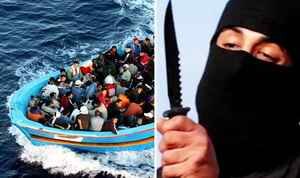 Judging from the scale of illegal migration to Europe in 2015, among the refugees there may be a certain number of supporters of the ideas of “radical Islamism”. We should take into consideration that the vast majority of refugees (76 %) in 2015 came from war-torn Syria, Iraq and Afghanistan. In November of 2015, this figure reached 92 %. First of all, these people are just trying to escape from the horrors of a variety of “caliphates”, so they are not prime candidates for the role of “Islamic terrorists”. It is significant that among the participants of the recent terrorist attacks in Paris on the 13th-14th of November, only two terrorists are suspected of having arrived in Europe from Syria, with a stream of refugees, while the rest — are the citizens of the EU (France and Belgium).
Judging from the scale of illegal migration to Europe in 2015, among the refugees there may be a certain number of supporters of the ideas of “radical Islamism”. We should take into consideration that the vast majority of refugees (76 %) in 2015 came from war-torn Syria, Iraq and Afghanistan. In November of 2015, this figure reached 92 %. First of all, these people are just trying to escape from the horrors of a variety of “caliphates”, so they are not prime candidates for the role of “Islamic terrorists”. It is significant that among the participants of the recent terrorist attacks in Paris on the 13th-14th of November, only two terrorists are suspected of having arrived in Europe from Syria, with a stream of refugees, while the rest — are the citizens of the EU (France and Belgium).
Besides, we should also take into consideration a fairly high risk of loosening and destabilization of the political situation in the countries of Eastern and South-Eastern Europe, in the first place — in the Balkans and in the Baltic countries. Thus, Bulgarian President Rosen Plevneliev has openly accused Russia of destabilizing the situation in the country and in the Balkans region. Montenegro's government has also openly called Russian special services the organizer of the latest unrest in the country. Let us also remember the recent clashes in Macedonia, the latest developments in Moldova and Romania. According to some sources, there is a “hand of Moscow” in all these events.
The growth of disagreements is expected among European countries in the allocation of quotas for the reception of refugees and the costs of the resolution of the migration crisis. It is predicted that the terrorist threats, the population's being not happy with the migration policies of their countries, and growth of anti-immigrant sentiments among ordinary Europeans will lead to an increase in the role and influence of the right (ultra-right), nationalist (ultra-nationalist) parties (movements and organizations) in the political life of most European countries.
What awaits Ukraine?
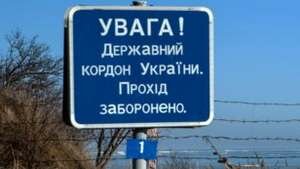 Ukraine, which has one of the longest land borders with Eastern European countries, quite expectedly may find itself in the role of Greece, Hungary and Serbia, as a transit country on the migrants' way to the European Union.
Ukraine, which has one of the longest land borders with Eastern European countries, quite expectedly may find itself in the role of Greece, Hungary and Serbia, as a transit country on the migrants' way to the European Union.
At present, the State Border Service (SBS) and the State Migration Service (SMS) of Ukraine do not record a significant increase in the flow of Syrian refugees through the country:
- the SMS of Ukraine since the beginning of 2015 have found out 4 612 illegal immigrants (for comparison — 3 518 in 2014, 1 723 — in 2013). Besides, over the last three years, Ukraine has received 723 applications for asylum by Syrian citizens (including 89 such applications since the beginning of 2015);
- the SBS units in Ukraine since the beginning of 2015 have detained 3 021 illegal migrants (for comparison — 2 709 people in 2014, and 1 950 — in 2013).
The minor scale of “the Middle East” migration to Ukraine is due to the inconvenient geographical location (as a transit country) regarding the main migration routes to the EU and unattractiveness because of problems in the economy and security (as host country).
However, in the coming months, according to experts, the number of migrants trying to get to Ukraine from Turkey via the Black Sea ports may grow. Also, the risk is high enough that a large number of migrants (in transit through the countries of Central Asia, Southern Caucasus and Russia) can be directed to the land section of the Russian-Ukrainian border.
In this context, Ukraine should not be lulled by the statements of the head of the Federal Migration Service of the Russian Federation K. Romodanovskiy that “...Russia is not a transit country” for refugees from the Middle East. This year into Norway through the “north-cycling” border with Russia there have got 4.5 thousand refugees, which is 10 times more than in 2014. Findland's President Sauli Niinistö has warned recently about the possibility of increased flow of migrants through the eastern border with Russia.
Negative factors which will affect the development of the situation:
- The Border Guard Service of the Russian Federation (closely integrated into the structure of the Russian FSB) will comprehensively promote smuggle of illegal migrants through the Russian-Ukrainian border;
- Each case of detention of illegal migrants on the western borders of Ukraine will be actively replicated by the Russian propaganda machine, including in the European media. Cases of detention by Russian national security services of supporters of “IS” will be exaggerated. Indicative in this respect were the latest “fakes” of the Russian so-called “media” about “thousands of militants of IS in Odessa” and “IS' recruiters in Kharkiv”;
- Russian security services will receive additional channels for infiltration of their agents into the territory of Ukraine;
- A general increase in the level of terrorist threat in Ukraine due to getting to its territory of supporters of radical Islamic movements;
- Additional risks of the prospect of introduction of visa-free regime for Ukrainian citizens.
 In general, according to experts of “Borysfen Intel”, next year the scale of the “immigration invasion” on European borders will remain the same, but it will not have a decisive negative impact on the prospects for the unity of the European Union. However, taking into consideration the huge profits of the organizers of people smuggling, who receive thousands of dollars for each “passenger” and geopolitical benefits for the governments of some countries — the so-called “sponsors” of illegal migration (mainly Syria, Turkey and Russia) for migrants there will be found and introduced new routes and methods of delivery.
In general, according to experts of “Borysfen Intel”, next year the scale of the “immigration invasion” on European borders will remain the same, but it will not have a decisive negative impact on the prospects for the unity of the European Union. However, taking into consideration the huge profits of the organizers of people smuggling, who receive thousands of dollars for each “passenger” and geopolitical benefits for the governments of some countries — the so-called “sponsors” of illegal migration (mainly Syria, Turkey and Russia) for migrants there will be found and introduced new routes and methods of delivery.
At the same time special services of certain countries will use the destructive potential of illegal migration to get influence and loosen the political stability of some European states through creation of new zones of tension, spreading of anti-immigrant sentiments and phobias, building up a critical mass of radical (Islamic) forces, and so on.
In such circumstances, in the situation of Russia's continuing aggression against Ukraine, and taking into consideration the aggravation of Russian-Turkish relations, it is very important for our country to pay more attention to the land section of the Russian-Ukrainian border and the high risk of potential growth of migration flows to Ukraine from Turkey via the Black Sea ports.

